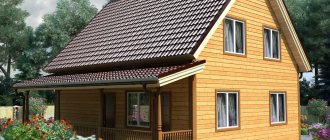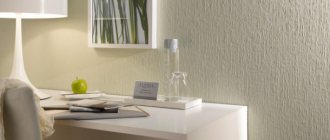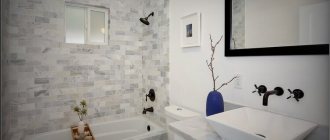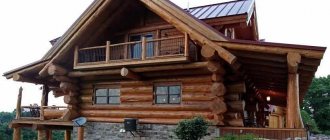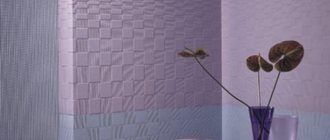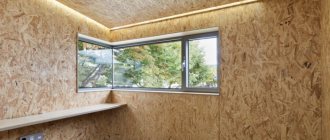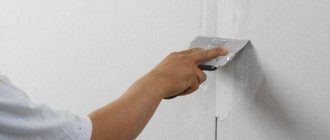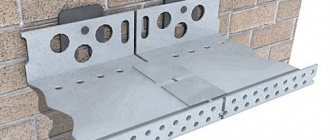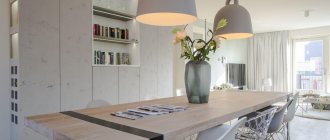Drywall is one of the most popular materials for renovation and construction. Its sheets can be used to create partitions, various structures or simple decoration of walls and ceilings. You can get a beautiful result with the help of finishing. We tell you how and with what to paint drywall to achieve a good result.
Advantages of painting works
The advantage of the solution is significant savings. A good quality paint coating is cheaper than other finishing materials along with consumables. The main thing is to choose what is better to paint the walls in the bathroom instead of tiling.
When finishing with tiles, you need a good glue for ceramics, a construction mixer, notched trowels for applying the mortar, and a trowel for spreading the mixture. Also moisture-resistant grout, a spatula for applying it.
Applying paint
Any person who has no knowledge or experience working with paints can handle painting.
Tile laying requires skill, tools to control even laying, you need to cut the tiles, and maintain the width of the seam.
Coloring allows you to combine shades and create beautiful patterns. Interesting stencils and textured rollers help to beautifully decorate walls and complement the design.
Paint selection
Painting plasterboard walls can be done using various types of paint. Water-based paint, oil paint or enamel are considered the most optimal for HA sheets.
Water-based paint
Painting drywall with water-based paint is the most common option for interior wall decoration. As a rule, this type of paint is available only in white. However, to obtain the desired color, you can add various tint dyes to it. But when adding color, you should remember that its component in the total volume should not exceed 5%.
Water-based paint for drywall results in a matte, velvety, visually pleasing surface with high performance characteristics. At the same time, such paint for drywall is quite easily washed off from the tools used during the work.
However, water-based emulsion also has a number of disadvantages. Firstly, this is a large consumption of paint even for small surfaces. Secondly, low resistance to moisture. Therefore, drywall painted with water-based paint will very quickly lose its original appearance in rooms with high levels of humidity and/or temperature changes, for example, when finishing the interior of a bathroom or kitchen.
The most popular paints for drywall are water-based paint, oil paint or enamel.
Enamel or oil paint
Painted drywall using oil paint or enamel perfectly resists moisture and high temperatures; changes in these indicators are not dangerous for it. Therefore, if painting the walls is chosen for the interior decoration of the kitchen or bathroom, then it is more expedient and rational to use various types of enamel or oil paints for this. In addition, their consumption per square meter of usable area is significantly less than when using a water-based composition.
Ways to cover batteries with plasterboard
Painting gypsum boards with these types of paints results in a smooth, glossy, but cold tactile surface. It is also worth noting that enamel and many oil paints contain various chemical compounds, many of which are quite toxic. Therefore, all finishing work using these paints must strictly be carried out in well-ventilated areas.
When deciding what paint to paint plasterboard walls, you should remember some of their properties. Water-based compositions, after complete drying, become several tones lighter, unlike oil paint or enamel. Those, on the contrary, dry out and acquire a darker shade.
Types of compositions
In addition to the main product line, dividing coloring compositions by purpose, there are detailed clarifications.
For example, to paint a bathroom you need a composition containing antibacterial substances that is resistant to moisture. A completely environmentally friendly product with high hygienic indicators, capable of passing air flows.
The paint for painting walls in the bathroom must be resistant to abrasion, since the main surface must be washed regularly.
Oil products
Oil products are less popular now, but are often used.
Painted surfaces can be washed with any chemicals, without abrasive substances in the composition. They do not absorb moisture and do not allow air to pass through.
The main active ingredients are drying oil and tint pigments. Depending on the scope of application, manganese, cobalt, talc or other additives are added.
Oil paint
You can buy two types of consistency - completely liquid, ready-made. You just need to stir it. Or paste-like, which is diluted with drying oil to the required state.
It is allowed to dilute with kerosene, turpentine, White Spirit, you need to add them a little, 5% of the total mass is enough.
It is better to apply with a hard brush.
Remember that different types of surfaces have their own composition: metal, concrete. Information is indicated on the packaging. Here the presence of additives is prescribed that accelerate drying, reducing the period to 2-3 days.
Alkyd enamel
Alkyd compounds repel water. This is important in this room. Treated surfaces are not afraid of dampness, are easy to clean with any means, retain their gloss and color well, and are resistant to abrasion.
If necessary, it can be diluted with a solvent.
Alkyd enamel
In order for the coating to lie flat and firmly, it must be applied at a positive temperature of 5-35 degrees. If it is colder or warmer, adhesion decreases.
When you don’t like glossy solutions, choose matte varieties.
Pigments increase color protection from ultraviolet radiation. When purchasing, you need to study the markings: for interior work, universal paints are better.
Application to substrates is accompanied by the release of a sharp, toxic odor, which makes it impossible to continue work without a respirator.
On a water dispersion basis
This liquid is produced from a dispersion of polymers, usually acrylic or vinyl acetate.
Non-toxic coating, since the composition does not contain volatile solvents.
Water emulsion
As the surface dries, it becomes covered with a durable and elastic protective film. It does not interfere with air flow.
There are three types of components: acrylic, silicone and PVA. The latter are for painting the ceiling. They are not moisture resistant and cannot be washed.
With added latex
Latex compositions are for very wet rooms, but they are quite expensive.
The elastic mass smooths out small irregularities and makes the surface beautiful.
The easy-to-apply emulsion dries quickly and emits a slightly unpleasant aroma when painting.
Latex products
In addition to elasticity and wear resistance, the compositions are resistant to mechanical damage.
It is necessary to pre-apply a primer with an antiseptic. You cannot paint at sub-zero temperatures or inside unheated rooms - it will crack due to exposure to cold.
Direct exposure to sunlight spoils the resulting color.
Acrylate mixture
Acrylic enamel
Walls are painted with such compositions. They dry quickly, smooth out minor imperfections, and retain their original shade for a long time. Antifungal additives prevent the development of mold due to increased humidity.
During application, a slight odor is released, which soon disappears.
Better than this are only silicone ones, which repel liquids better, have a dense protective film, long-lasting shade and glossy shine. This is not the cheapest paint, but the costs are still lower than when laying ceramics.
Its analogue is a chlorinated rubber composition for painting swimming pools.
Glossy or matte?
All types of coloring agents are glossy, semi-matte, matte.
Gloss reflects light, a shiny surface visually expands the room. Painting the ceiling with this substance helps to visually enlarge the bathroom.
The smooth coating is easy to clean; cleaning will have to be done more often; the slightest droplets on the surface are noticeable. Does not cover minor flaws of the base, emphasizes them.
Matte painting is better at masking defects; creating completely smooth walls is technically impossible.
Once dry, the structure remains slightly porous, making cleaning difficult. Other qualities allow matte paint to compete with glossy paint.
The golden mean would be semi-matte products that reflect light a little and look good where they are applied.
Textured compositions
If you want to make your bathroom unusual, you can use textured compositions.
The viscous, dense structure allows you to create patterns of varying complexity using a special tool.
The paint is applied to the walls, then the designs are made with a textured roller. It is possible to use different application techniques; the desired shade is displayed with a color scheme, since the color of the product is always white.
Preliminary application is carried out with a brush, roller, spatula.
When the mass is thick, it can be brought to a liquid state by diluting with clean water.
Without violating the operating technology, the coating does not lose its quality for many years in a row, fades slowly, and easily tolerates temperature changes.
A more detailed review of bathroom paint in the following video:
Proper sealing of joints of gypsum board sheets is the key to high-quality painting
Joints of gypsum board sheets are a problem that many people encounter when painting. Nothing seems to be a sign of trouble, but literally after half a year, or even less, cracks will form on the already painted wall. These cracks form at the joints of sheets.
Let's find out why this happens and how to avoid it. The fact is that many craftsmen seal the joints of gypsum board sheets with a “serpyanka” mesh, which does not sufficiently reinforce the seam and the seams crack. To seal gypsum board seams, it is better to use paper tape, or even better, combine both serpyanka and tape, and also putty the entire drywall in two layers! But this is already a bit expensive, so we are considering an option without putty.
To seal gypsum board joints for painting, instead of “serpyanka”, it is better to use a special paper tape for gypsum board joints.
Tape for joints of drywall sheets
You can also stick sickle tape onto the joints under the wallpaper; you still can’t see under the wallpaper that cracks have appeared, and this won’t cause the wallpaper to tear, but you need to use tape when painting drywall.
I recommend: How to make a plasterboard ceiling (GKL), plasterboard ceiling with your own hands
It is better to seal the joints with a special putty, especially for gypsum board joints, it is stronger and more reliable. Self-tapping screws screwed into the gypsum board must be recessed into the sheet and these places must also be puttied.
The joints are glued with paper tape and puttied, the holes from the screws are also
Preparation
Before you paint the walls in the bathroom, you need to prepare them. The process will be divided into three stages, which are best studied more closely.
Removing the previous coating
First you need to completely remove the old finish - clean off the paint, remove the tiles if they are laid.
This is a labor-intensive stage that requires the most effort and time. It is necessary to thoroughly clean the surfaces with a spatula.
Remove the paint by hand, and remove anything that cannot be removed with a tool using chemical means.
Knock down the tiles with a hammer and chisel and level the walls.
Clean to zero level – down to concrete or brick.
Surface putty
If cracks are found on the base, they are widened, puttyed, left to dry, and if mold is detected, the walls are treated with an antiseptic.
When the surface is sufficiently smooth, remove minor imperfections. Otherwise, complete coverage with putty is performed.
The solution is kneaded according to the instructions until the consistency of thick sour cream. Apply with a wide spatula.
If necessary, the walls are aligned with the beacons.
Base primer
After the putty has completely dried, dust and dirt are removed.
The primer mixture is applied with a brush or roller, making one layer first. After 7-10 hours, apply the second layer. If this is required, make even more layers, but not less than two.
You need to use a primer with antiseptics to prevent the development of mold or mildew on all surfaces.
Requirements for installation of gypsum boards for high-quality painting
For high-quality painting, drywall must first be installed correctly and efficiently. It is desirable that the requirements of SNiP be observed, and if we deviate from them, then not by much and understanding where. In general, partitions and ceilings must be strong, and plasterboard sheets on the wall to be leveled must be firmly fixed to it. Why such requirements? So that the paint doesn't crack.
The disadvantage of plasterboard structures is that it noticeably transmits vibrations and if installed incorrectly, the plastered areas at the joints of gypsum board sheets may crack, which will ruin the entire finish. If you carry out the installation yourself, take into account all the nuances of installing gypsum boards, and there are many of them, or order installation from professionals.
Not only must the gypsum board be installed correctly, but also proper painting work must be carried out on it, including sealing the joints of the gypsum board sheets and putting them on.
Apply paint
Painting the walls any color in the bathroom is a simple matter.
After opening the package, mix the contents thoroughly until smooth. At this stage, tinting agents or thinning components are added.
First, hard-to-reach areas are painted - they make edging along the top and bottom, around doors, windows, and paint corners and joints with a brush.
A larger surface is painted with a roller. It is important to immediately remove any stains that appear so as not to spoil the appearance of the wall.
Let the first layer dry. The manufacturer writes the drying time on the packaging. Afterwards you can apply a new layer.
Preparing the base for painting
After high-quality puttying of the joints and filling of holes from self-tapping screws, the surface that was puttyed must be sanded a little with sandpaper (150-220), thereby removing small sagging and unevenness of the putty. If necessary, the puttying procedure can be repeated in places. Next, you need to prime the surface for high-quality painting. We prime with deep penetration soil, preferably 2 times. Let it dry according to the instructions or a little more.
Preparation for painting drywall
Wall decoration
A solid color looks neat and advantageous. You can make your bathroom more interesting and give it an unusual look with additional decoration.
Coloring with stencils
Light patterns, ornaments, images of animals or objects can simply be applied with a stencil.
Blanks can be purchased ready-made, ordered, or made on your own.
For even application, the stencil is secured with tape to a dry wall.
Stripes on the walls
Horizontal stripes will visually expand the room, vertical stripes will save you with low ceilings.
Contrasting colors and similar shades look interesting.
To ensure that the lines are straight, markings are applied using a plumb line or a building level. Apply masking tape along the marked lines.
It is removed when the paint has set slightly, before it begins to dry, so as not to damage the integrity of the coating.
Applications using rollers
There are rollers with convex patterns.
First apply the base color, then dip the roller into the paint. It needs to be rolled out well before application.
It is important to ensure that the drawings do not overlap each other, otherwise the wall will look sloppy.
How to paint drywall yourself
Well, we got to the actual painting. Painting drywall is not as difficult as installing and preparing it, but it also has its own subtleties and nuances. Again, I suggest → ordering painting work (via the link, again in Moscow) in order to make your life easier. Painting work also includes sealing plasterboard joints, so you can order as a whole, a partition or ceiling, or leveling gypsum plasterboard walls for painting.
If you have decided on all this and think that the installation of drywall was carried out correctly, the joints are sealed correctly, let's start painting it.
What paint to use
Almost any water-based paint can be used. The main thing is that the label says that you can paint the walls and ceiling. These can be acrylic, latex and other paints. But only water-based! There is no need to use any smelly enamels for drywall; that is not what they are intended for in the age of water-based paints.
A variety of paints can provide either a glossy or matte finish depending on your preference. Also, modern water-based paints have either a rich, bright color or can be simply white. White paints can be given the desired shade using tint.
Variety of paint colors
Give the paint the desired tone
To give a plasterboard wall the tone you need, you need to try several options and come to the right one through trials. We mix a small amount of paint with the necessary colors and try to paint it, preferably in an area where it will be less noticeable in the future, for example, where the furniture will subsequently stand. You will still paint this area in 2 layers, but it is possible that the texture from 3-4 layers of paint that you first tried and then painted over will remain.
Painted paint in a bucket, wet paint applied to drywall and already dried paint - these are 3 different shades!
Here you can get a little confused, and, most importantly, wait until the paint dries (for water-based compositions this is 1-2 hours) and then look at the shade. It is important to understand that paint applied in one layer to green or gray drywall may show through and the shade may vary.
To choose the right color and tone of paint, try painting a small and inconspicuous area
There is one more subtlety here that needs to be mentioned. The paint can be tinted to a certain tone already in the store, which will save you from the difficulties of tinting it. But the difficulty is this: one tone of paint you have tinted may not be enough to cover the entire surface and you will have to tint it again, and since you are tinting it yourself, you will not be able to achieve exactly the same tone. The result will only be as close as possible to this. Therefore, either tint the paint to the entire volume
area to be painted, or at least one layer, since if you apply a second layer of almost the same tone, nothing bad will happen.
When tinting, follow the instructions for the paint, which indicate the consumption per m², plus make a reserve of 10-20% of the paint so that it is enough for the entire volume of the surface to be painted.
To make the paint as close as possible in color, leave the rest of the paint and mix the color with new paint, achieve the same shade.
I recommend: How to bend (bend, bend) drywall (gypsum plasterboard)
Preparing the paint for application
Water-based compositions are already ready for application, but you can dilute them with water by 10% of the volume. This way the paint will become more pliable, it will be more convenient to paint, and there will be more of it 
Mixing paint with both water and color takes a long time and is tedious. Only, if you dilute the paint, first dilute it, and then add color.
It’s better to mix the paint with a long wooden or plastic stick (almost any item will do, even if it’s not a necessary kitchen utensil). I don’t recommend using metal “stirrers” because they scratch the plastic bucket and shavings can get into the paint, although this is unlikely and not particularly scary. In general, it is better to use something wooden or plastic.
You need to mix it by stirring evenly for about 10 minutes. You can use a new or just a clean metal whisk for a hammer drill or drill and mix at low speed.
Mixing paint with color
The paint has been prepared, painted in the desired tone, it’s time to get to work.
Drywall painting
We will need painting tools:
- A brush, preferably two: a larger one and a smaller one (say 2-3 cm and 8-10 cm).
- Paint roller for water-based paints, with short pile (that’s what it’s called for water-based paints).
- Tray for roller and paint.
- Masking tape!
Let's start painting again with preparation, namely with those places that need to be covered with masking tape so as not to paint them. These are places under the ceiling, under the ceiling plinth, at the joints with other painted parts of the wall, etc. Everything needs to be carefully and tightly sealed with masking tape so that the paint does not seep into it.
Cover everything that needs to be covered with masking tape.
Pour paint into the tray. Roll out the roller in the paint so that it is well and evenly saturated with paint.
. This may take 2-3 minutes, but this is only the first time. You can even leave the roller to soak for 5 minutes, it will be even better, but without fanaticism. Having evenly applied and soaked the roller with paint, roll it out in the tray so that there is enough paint on it for application and it does not drip off it. Do not press the roller too hard when rolling.
We apply paint to the wall strictly in one direction: either vertically or horizontally. We do the second layer in reverse. It’s not possible to do it strictly in one direction everywhere, but you need to try to follow this principle as much as possible.
Apply the paint in sections, evenly rolling the roller over the surface in a “herringbone” pattern, moving up and down (or left and right).
Option for applying paint with a roller to the wall
Distribute the paint evenly over the surface, do not allow it to be less in some places and more in others. When you have applied it for the first time and the paint on the roller has run out, you wet the roller with paint (roll it out in the bath) again and paint the next section of the wall, and here it is important to go beyond the boundaries of the previous layer, achieving uniform application and so that transitions/differences do not form. The pressure on the roller is less than average.
Applying paint to the wall and under the ceiling/floor
Under the ceiling and floor, you can break the rule of painting in one direction, provided you paint the area in the right way. That is, you can apply it once in the “wrong” one and smooth out the paint in the right one.
I recommend: Drywall for finishing a loggia or balcony
Use a brush with soft, thick bristles where needed. Spread the paint evenly and, if necessary, roll the area again with a roller. While the paint is in working condition (this is about 10 minutes), it can be distributed as desired.
After the first layer has dried (according to the instructions, about 1-2 hours), apply the second, everything is about the same. Don't worry if you don't see the result you expected immediately after painting, everything will change when the paint dries!
After the second layer has dried, you will need to remove the masking tape. Remove it carefully! To avoid damaging already painted surfaces and wallpaper, do it slowly and without rushing.
Carefully remove the masking tape after painting


